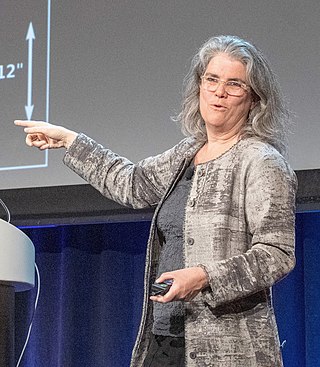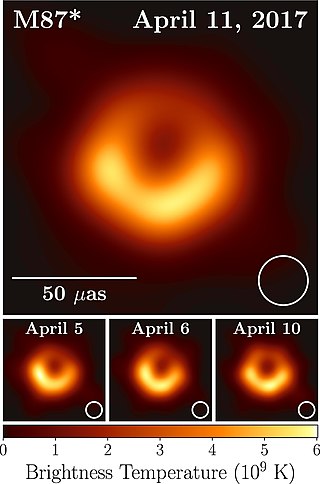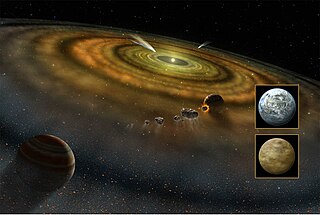Related Research Articles

The National Optical Astronomy Observatory (NOAO) was the United States national observatory for ground-based nighttime ultraviolet-optical-infrared (OUVIR) astronomy. The National Science Foundation (NSF) funded NOAO to provide forefront astronomical research facilities for US astronomers. Professional astronomers from any country in the world could apply to use the telescopes operated by NOAO under the NSF's "open skies" policy.

Andrea Mia Ghez is an American astrophysicist, Nobel laureate, and professor in the Department of Physics and Astronomy and the Lauren B. Leichtman & Arthur E. Levine chair in Astrophysics, at the University of California, Los Angeles. Her research focuses on the center of the Milky Way galaxy.

Didier Patrick Queloz is a Swiss astronomer. He is the Jacksonian Professor of Natural Philosophy at the University of Cambridge, where he is also a fellow of Trinity College, Cambridge, as well as a professor at the University of Geneva. Together with Michel Mayor in 1995, he discovered 51 Pegasi b, the first extrasolar planet orbiting a Sun-like star, 51 Pegasi. For this discovery, he shared the 2019 Nobel Prize in Physics with Mayor and Jim Peebles. In 2021, he was announced as the founding director of the Center for the Origin and Prevalence of Life at ETH Zurich.

The Center for Astrophysics | Harvard & Smithsonian (CfA), previously known as the Harvard–Smithsonian Center for Astrophysics, is an astrophysics research institute jointly operated by the Harvard College Observatory and Smithsonian Astrophysical Observatory. Founded in 1973 and headquartered in Cambridge, Massachusetts, United States, the CfA leads a broad program of research in astronomy, astrophysics, Earth and space sciences, as well as science education. The CfA either leads or participates in the development and operations of more than fifteen ground- and space-based astronomical research observatories across the electromagnetic spectrum, including the forthcoming Giant Magellan Telescope (GMT) and the Chandra X-ray Observatory, one of NASA's Great Observatories.

BD+20°307 is a close binary star system approximately 300 light-years away in the constellation Aries. The system is surrounded by a dusty ring, and probably orbited by a 0.48M☉ white dwarf on a wide orbit.
Dale A. Frail is a Canadian astronomer working at the National Radio Astronomy Observatory (NRAO) in Socorro, New Mexico.

A debris disk, or debris disc, is a circumstellar disk of dust and debris in orbit around a star. Sometimes these disks contain prominent rings, as seen in the image of Fomalhaut on the right. Debris disks are found around stars with mature planetary systems, including at least one debris disk in orbit around an evolved neutron star. Debris disks can also be produced and maintained as the remnants of collisions between planetesimals, otherwise known as asteroids and comets.

Feryal Özel is a Turkish-American astrophysicist born in Istanbul, Turkey, specializing in the physics of compact objects and high energy astrophysical phenomena. As of 2022, Özel is the Department Chair and a professor at the Georgia Institute of Technology School of Physics in Atlanta. She was previously a professor at the University of Arizona in Tucson, in the Astronomy Department and Steward Observatory.

HR 8799 is a roughly 30 million-year-old main-sequence star located 133.3 light-years away from Earth in the constellation of Pegasus. It has roughly 1.5 times the Sun's mass and 4.9 times its luminosity. It is part of a system that also contains a debris disk and at least four massive planets. Those planets, along with Fomalhaut b, were the first exoplanets whose orbital motion was confirmed by direct imaging. The star is a Gamma Doradus variable: its luminosity changes because of non-radial pulsations of its surface. The star is also classified as a Lambda Boötis star, which means its surface layers are depleted in iron peak elements. It is the only known star which is simultaneously a Gamma Doradus variable, a Lambda Boötis type, and a Vega-like star.

Fomalhaut b, formally named Dagon, is a directly imaged extrasolar object and former candidate planet observed near the A-type main-sequence star Fomalhaut, approximately 25 light-years away in the constellation of Piscis Austrinus. The object's discovery was initially announced in 2008 and confirmed in 2012 via images taken with the Advanced Camera for Surveys (ACS) on the Hubble Space Telescope. Under the working hypothesis that the object was a planet, it was reported in January 2013 that it had a highly elliptical orbit with a period of 1,700 Earth years. The object was one of those selected by the International Astronomical Union as part of NameExoWorlds, their public process for giving proper names to exoplanets. The process involved public nomination and voting for the new name. In December 2015, the IAU announced the winning name was Dagon.

HR 8799 b is an extrasolar planet located approximately 129 light-years away in the constellation of Pegasus, orbiting the 6th magnitude Lambda Boötis star HR 8799. It has a mass between 4 and 7 Jupiter masses and a radius from 10 to 30% larger than Jupiter's. It orbits at 68 AU from HR 8799 with an unknown eccentricity and a period of 460 years, and is the outermost known planet in the HR 8799 system. Along with two other planets orbiting HR 8799, the planet was discovered on November 13, 2008 by Marois et al., using the Keck and Gemini observatories in Hawaii. These planets were discovered using the direct imaging technique.

HR 8799 c is an extrasolar planet located approximately 129 light-years away in the constellation of Pegasus, orbiting the 6th magnitude Lambda Boötis star HR 8799. This planet has a mass between 5 and 10 Jupiter masses and a radius from 20 to 30% larger than Jupiter's. It orbits at 38 AU from HR 8799 with an unknown eccentricity and a period of 190 years; it is the 2nd planet discovered in the HR 8799 system. Along with two other planets orbiting HR 8799, this planet was discovered on November 13, 2008, by Marois et al., using the Keck and the Gemini observatories in Hawaii. These planets were discovered using the direct imaging technique. In January 2010, HR 8799 c became the 3rd exoplanet to have a portion of its spectrum directly observed, confirming the feasibility of direct spectrographic studies of exoplanets.

HR 8799 d is an extrasolar planet located approximately 129 light-years away in the constellation of Pegasus, orbiting the 6th magnitude Lambda Boötis star HR 8799. It has a mass between 5 and 10 Jupiter masses and a radius from 20 to 30% larger than Jupiter's. The planet orbits at 24 AU from HR 8799 with an eccentricity greater than 0.04 and a period of 100 years. Upon initial discovery, it was the innermost known planet in the HR 8799 system, but e, discovered later, is now known to be closer to their parent star. Along with two other planets orbiting HR 8799, this planet was discovered on November 13, 2008 by Marois et al., using the Keck and Gemini observatories in Hawaii. These planets were discovered using the direct imaging technique.
74503 Madola (provisional designation 1999 DN4) is a background asteroid from the outer region of the asteroid belt, approximately 4.5 kilometers in diameter. It was discovered on 23 February 1999, by Canadian astronomer Denis Bergeron at the Val-des-Bois Observatory in Quebec, Canada. The asteroid was named for the three Canadian astronomers Christian Marois, René Doyon and David Lafrenière.
Vyacheslav Gennadievich Turyshev is a Russian physicist now working in the US at the NASA Jet Propulsion Laboratory (JPL). He is known for his investigations of the Pioneer anomaly, affecting Pioneer 10 and Pioneer 11 spacecraft, and for his attempt to recover early data of the Pioneer spacecraft to shed light on such a phenomenon.

HR 8799 e is a large exoplanet, orbiting the star HR 8799, which lies 129 light-years from Earth. This gas giant is between 5 and 10 times the mass of Jupiter. Due to their young age and high temperature all four discovered planets in the HR 8799 system are large, compared to all gas giants in the Solar System.

An exocomet, or extrasolar comet, is a comet outside the Solar System, which includes rogue comets and comets that orbit stars other than the Sun. The first exocomets were detected in 1987 around Beta Pictoris, a very young A-type main-sequence star. There are now a total of 27 stars around which exocomets have been observed or suspected.

HD 95086 b, formally named Levantes, is a confirmed, directly imaged exoplanet orbiting the young, 17 Myr A-class pre-main-sequence star HD 95086. It is roughly 5 times as massive as Jupiter and orbits about 70 AU away from the parent star. It was detected at thermal infrared wavelengths (3.8 μm) through direct imaging, using the NACO instrument on the VLT. A debris disk has been detected in this system at submillimeter wavelengths and has been resolved in the far-infrared from data obtained with the Herschel Space Observatory.

Lorenzo Iorio, born in Bari in, is an Italian physicist working in general relativity, gravitation and related topics in astronomy and astrophysics.
References
- ↑ John Simon Guggenheim Memorial Foundation (1976). Reports of the President and the Treasurer - John Simon Guggenheim Memorial Foundation. John Simon Guggenheim Memorial Foundation. ISSN 0190-227X . Retrieved 2015-04-10.
- ↑ Benjamin Zuckerman webpage on UCLA Department of Physics and Astronomy website.
- ↑ Benjamin Zuckerman publication list on NASA ADS
- ↑ Zuckerman, Benjamin (2001). "Dusty Circumstellar Disks". Encyclopedia of Astronomy and Astrophysics. Bibcode:2001eaa..bookE1845Z. doi:10.1888/0333750888/1845. ISBN 0-333-75088-8. "Encyclopedia of Astronomy and Astrophysics". Archived from the original on 2014-11-22. Retrieved 2009-08-17.
- ↑ Marois, Christian; et al. (November 2008). "Direct Imaging of Multiple Planets Orbiting the Star HR 8799". Science . 322 (5906): 1348–1352. arXiv: 0811.2606 . Bibcode:2008Sci...322.1348M. doi:10.1126/science.1166585. PMID 19008415. S2CID 206516630.
- ↑ Marois, C.; Zuckerman, B.; Konopacky, Q. M.; MacIntosh, B.; Barman, T. (2010). "Images of a fourth planet orbiting HR 8799". Nature. 468 (7327): 1080–1083. arXiv: 1011.4918 . Bibcode:2010Natur.468.1080M. doi:10.1038/nature09684. PMID 21150902. S2CID 4425891.
- ↑ Google Books link to the 1995 2nd edition of the book
- ↑ Description of the book on AbeBooks website.